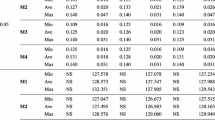Abstract
A portfolio prediction model based on Bayesian game algorithm is proposed to improve the accuracy of correlation analysis model in portfolio application. Firstly, the portfolio problem is analyzed. The market value constraint and the upper bound constraint are combined considering the general portfolio model according to Markowitz theory, it improves the portfolio model and obtains the portfolio model with mixed constraints. Secondly, a probabilistic portfolio monitoring strategy based on incomplete information non-cooperative Bayesian game is proposed. The framework combines the enterprise investment behavior detection module with the specified rules to identify the portfolio pattern, the interaction between portfolio selection and monitored investment behavior is modeled as a two-person non-cooperative Bayesian game, which allows portfolio selection to adopt a probability monitoring strategy based on game Bayesian Nash equilibrium, thereby reducing the computational complexity of the portfolio approach introduced into the game algorithm. Finally, the effectiveness of the proposed algorithm is verified by simulation experiments.



Similar content being viewed by others
References
Goswami M, Pratap S, Kumar SK (2016) An integrated Bayesian-Game theoretic approach for product portfolio planning of a multi-attributed product in a duopolistic market[J]. Int J Prod Res 54(23):6997–7013
Guan DJ, Guo P (2014) Constructing interdependent risks network of project portfolio based on bayesian network[C]// International Conference on Management Science & Engineering
Hill A, Mesens N, Steemans M et al (2013) Comparisons between in vitro whole cell imaging and in vivo zebrafish-based approaches for identifying potential human hepatotoxicants earlier in pharmaceutical development[J]. Drug Metab Rev 39(4):372–376
Hung JC, Weng JD, Chen YH (2016) A recommendation system based on mining human portfolio for museum navigation[J]. Evol Syst 7(2):145–158
Peña D, Poncela P (2006) Nonstationary dynamic factor analysis[J]. Journal of Statistical Planning & Inference 136(4):1237–1257
Piotroski JD, So EC (2012) Identifying Expectation Errors in Value/Glamour Strategies: A Fundamental Analysis Approach[J]. Rev Financ Stud 25(9):2841–2875
Rajendra Achary U, Hagiwara Y, Deshpande SN, Suren S, Koh JEW, Oh SL, Arunkumar N, Ciaccio EJ, Lim CM (Feb 2019) Characterization of Focal EEG Signals: A Review. Futur Gener Comput Syst 91:290–299
Smith JE, Winkler RL (2006) The Optimizer's Curse: Skepticism and Postdecision Surprise in Decision Analysis[J]. Manag Sci 52(3):311–322
Smith JE, Winterfeldt DV (2004) Decision Analysis in "Management Science"[J]. Manag Sci 50(5):561–574
Stanhouse B (1986) Commercial Bank Portfolio Behavior and Endogenous Uncertainty[J]. J Financ 41(5):1103–1114
Wang G, Simpson T (2013) Fuzzy Clustering Based Hierarchical Metamodeling for Design Optimization[J]. Eng Optim 36(3):313–335
Zhang C, Chaudhuri K (2014) Beyond Disagreement-based Agnostic Active Learning[J]. Adv Neural Inf Proces Syst 1:442–450
Zhou X, Nakajima J, West M (2014) Bayesian forecasting and portfolio decisions using dynamic dependent sparse factor models[J]. Int J Forecast 30(4):963–980
Author information
Authors and Affiliations
Corresponding author
Additional information
Publisher’s note
Springer Nature remains neutral with regard to jurisdictional claims in published maps and institutional affiliations.
Rights and permissions
About this article
Cite this article
Luo, H. Multimedia Portfolio Behavior Analysis Based on Bayesian Game Algorithm. Multimed Tools Appl 79, 35491–35501 (2020). https://doi.org/10.1007/s11042-019-07954-x
Received:
Revised:
Accepted:
Published:
Issue Date:
DOI: https://doi.org/10.1007/s11042-019-07954-x




